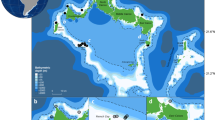Abstract
Larvae of the rock crab Cancer irroratus Say were hatched and reared under controlled laboratory conditions of temperature and salinity. Zoeae (Stages I–V) and megalopae were exposed to 5 sets of experimental conditions in an experimental column. Variables investigated included darkness, cool-white fluorescent light, and column orientation (horizontal or vertical). Results indicated a positive phototaxis throughout larval development, with the extent of photopositive movement decreasing slightly as metamorphosis to the megalopal stage approached. Conversely, responses to gravity appeared to change significantly as development proceeded, culminating in a rather abrupt and complete transition from geonegative to geopositive behavior in Stage V zoeae. This strong geopositive movement resulted in a change from a planktonic to a benthic habit.
Similar content being viewed by others
Literature Cited
Barr, A.J. and J.H. Goodnight: A user's guide to the statistical analysis system, 260 pp. Raleigh, N.C.: North Carolina State University 1972
Bigford, T.E.: Effects of oil on behavioral responses to light, pressure and gravity in larvae of the rock crab Cancer irroratus. Mar. Biol. 43, 137–148 (1977)
Bigford, T.E.: Synopsis of available information for the rock crab, Cancer irroratus Say. NOAA tech. Rep. U. S. Dep. Comm. natn. mar. Fish. Serv. (In press)
Ennis, G.P.: Behavioral responses to changes in hydrostatic pressure and light during larval development of the lobster Homarus gammarus. J. Fish. Res. Bd Can. 30, 1349–1360 (1973)
—: Behavioral responses to changes in hydrostatic pressure and light during larval development of the lobster Homarus americanus. J. Fish. Res. Bd Can. 32, 271–281 (1975)
Fogarty, M.J.: Competition and resource partitioning in two species of Cancer (Crustacea, Orachyura), 93 pp. M. Sc. thesis, University of Rhode Island 1976
Forward, R.B., Jr. and J.D. Costlow, Jr.: The ontogeny of phototaxis by larvae of the crab Rhithropanopeus harrisii. Mar. Biol. 26, 27–33 (1974)
Foxon, G.E.H.: Notes on the swimming methods and habits of certain crustacean larvae. J. mar. biol. Ass. U.K. 10, 829–849 (1934)
Hardy, A.C. and R. Bainbridge: Effect of pressure on the behavior of decapod larvae (Crustacea). Nature, Lond. 167, 354–355 (1951)
Hicks, S.D.: The physical oceanography of Narragansett Bay. Limnol. Oceanogr. 4, 316–327 (1959)
Hughes, D.A. and J.D. Richard: Some current-directed movements of Macrobrachium acanthurus (Wiegman, 1836) (Decapoda, Palaemonidae) under laboratory conditions. Ecology 54, 927–929 (1973)
Jones, C.: The ecology and metabolic adaptation of Cancer irroratus Say, 83 pp. M. Sc. thesis, University of Rhode Island 1973
Latz, M.I. and R.B. Forward, Jr.: The effect of salinity upon phototaxis and geotaxis in a larval crustacean. Biol. Bull. mar. biol. Lab., Woods Hole 153, 163–179 (1977)
Meade, R.H.: Landward transport of bottom sediments in estuaries of the Atlantic coastal plain. J. sedim. Petrol. 39, 222–234 (1969)
Ott, F.S. and R.B. Forward, Jr.: The effect of temperature on phototaxis and geotaxis by larvae of the crab Rhithropanopeus harrisii (Gould). J. exp. mar. Biol. Ecol. 23, 97–107 (1976)
Sandifer, P.A.: Distribution and abundance of decapod crustacean larvae in the York River Estuary and adjacent lower Chesapeake Bay, Virginia, 1968–1969. Chesapeake Sci. 14, 235–257 (1973)
—: The role of pelagic larvae in recruitment to populations of adult crustaceans in the York River Estuary and adjacent lower Chesapeake Bay, Virginia. Estuar. cstl mar. Sci. 3, 269–279 (1975)
Sastry, A.N.: The larval development of the rock crab, Cancer irroratus Say, 1817, under laboratory conditions. Crustaceana 32, 155–168 (1977)
Sulkin, S.D.: Behavioral responses of the developmental stages of two xanthid crabs to light, gravity and pressure under laboratory conditions, 141 pp. Ph. D. thesis, Duke University 1971
—: Depth regulation of crab larvae in the absence of light. J. exp. mar. Biol. Ecol. 12, 73–82 (1973)
—: The influence of light in the depth regulation of crab larvae. Biol. Bull. mar. biol. Lab., Woods Hole 148, 333–343 (1975)
Thorson, G.: Light as an ecological factor in the dispersal and settlement of larvae of marine bottom invertebrates, Ophelia 1, 167–208 (1964)
Author information
Authors and Affiliations
Additional information
Communicated by M.R. Tripp, Newark
Rights and permissions
About this article
Cite this article
Bigford, T.E. Ontogeny of light and gravity responses in rock crab larvae (Cancer irroratus). Mar. Biol. 52, 69–76 (1979). https://doi.org/10.1007/BF00386859
Accepted:
Issue Date:
DOI: https://doi.org/10.1007/BF00386859




